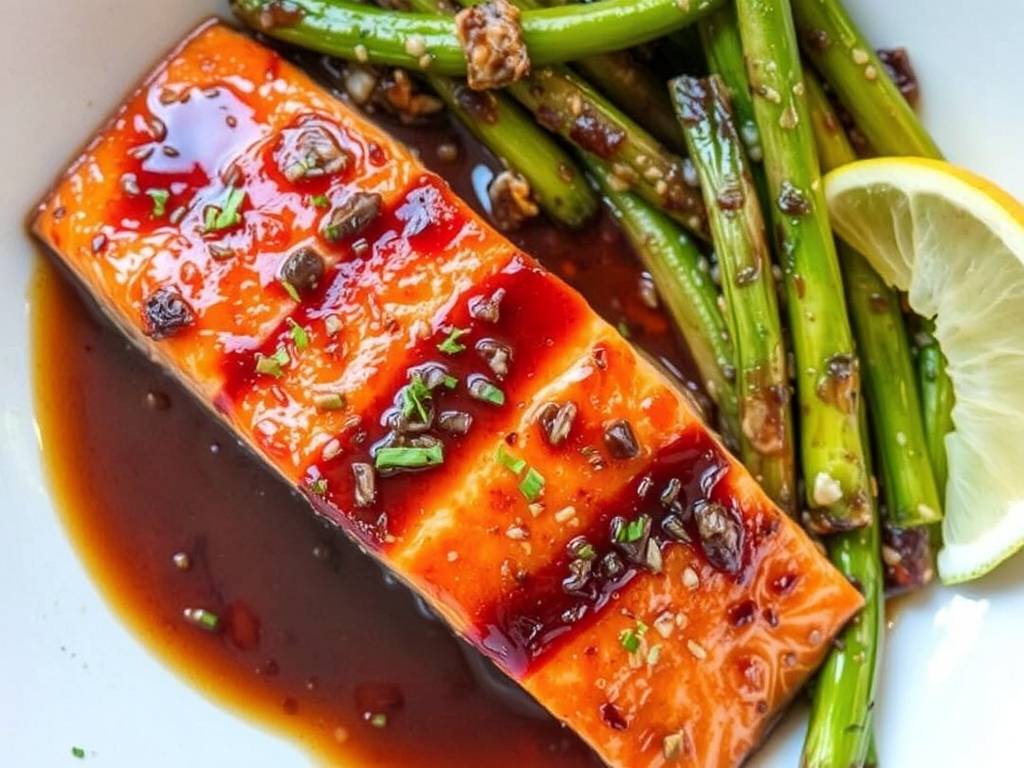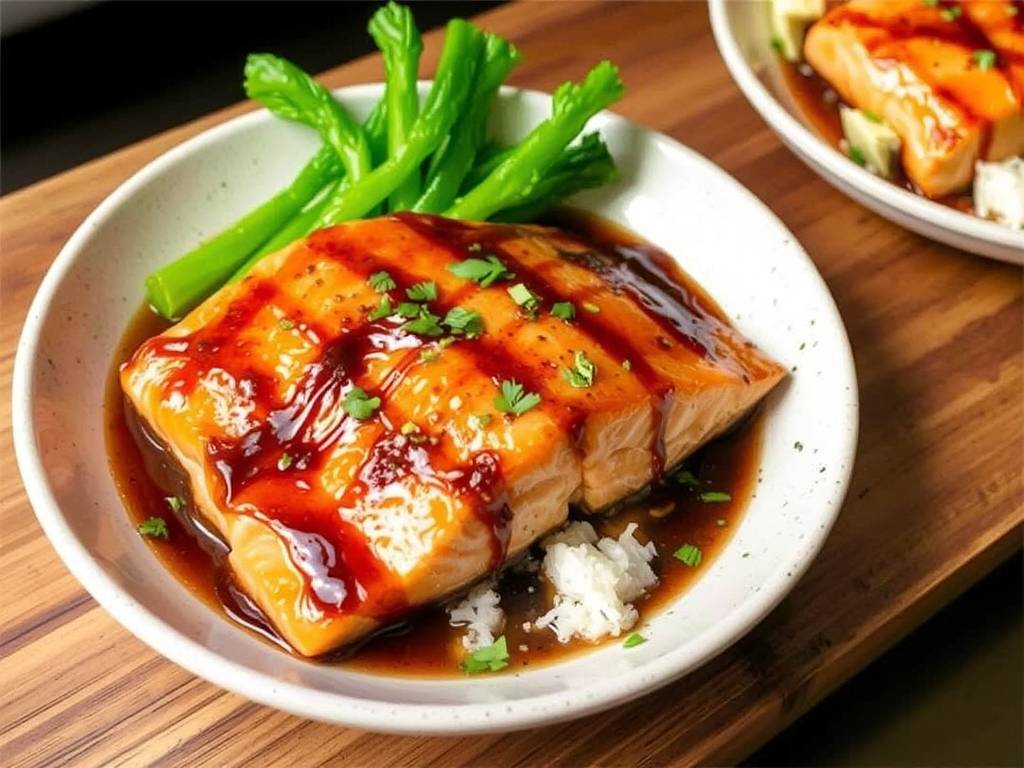The Ultimate Guide to Perfectly Baked Salmon with Soy and Ginger Glaze
There's something truly magical about a perfectly baked piece of salmon. When it's cooked just right, the flesh is tender, flaky, and melts in your mouth. But let's be honest, sometimes plain baked salmon can feel a little... well, plain. That's where this incredible Soy and Ginger Glaze comes in. It transforms a simple piece of fish into a restaurant-quality dish that is bursting with umami, sweet, and savory flavors. If you've ever wondered how to bake salmon so it's never dry, or how to create a glaze that truly sticks and caramelizes, you've come to the right place. This guide will walk you through every single step, from selecting your fillet to the final, glorious presentation.
First things first, let's talk about the star of the show: the salmon. Choosing the right cut is your first step toward success. You'll often find salmon sold as individual fillets or as one large side. For this recipe, I highly recommend skin-on, center-cut fillets. The skin acts as a natural barrier, protecting the delicate flesh from the direct heat of the pan and locking in moisture. A common mistake many home cooks make is using thin, tail-end pieces that cook too quickly and are prone to drying out. A thicker, center-cut fillet is much more forgiving and will give you that beautiful, moist interior. Whether you choose Atlantic, Sockeye, or King salmon is up to your personal taste and budget, but aim for fillets that are about 1 to 1.5 inches thick for the best results.

Now, let's dive into the heart of the flavor—the homemade soy ginger glaze for salmon. This isn't just a simple mixture of soy sauce and ginger; it's a carefully balanced symphony of ingredients that will make your taste buds sing.
Here’s what you’ll need for the glaze:
- 1/3 cup low-sodium soy sauce: Using low-sodium allows you to control the salt level better.
- 3 tablespoons honey or maple syrup for a deeper flavor.
- 1 tablespoon freshly grated ginger: Please, do not use the powdered stuff! Fresh ginger is non-negotiable for that bright, zesty punch.
- 2 cloves garlic, minced: Fresh is best here, too.
- 1 tablespoon rice vinegar: This adds a crucial touch of acidity to balance the sweetness and saltiness.
- 1 teaspoon sesame oil: A little goes a long way in providing a nutty, aromatic base.
- Optional for heat: 1 teaspoon of Sriracha or a pinch of red pepper flakes.
The process of making the glaze is simple but important. In a small saucepan, combine all the ingredients. Whisk them together over medium heat until the honey has fully dissolved. Then, let it simmer for 5-7 minutes, stirring occasionally, until the sauce has reduced slightly and thickened enough to coat the back of a spoon. This reduction step is a pro-tip for achieving a sticky glaze for fish. A thin, watery sauce will just slide off the salmon, but a slightly thickened glaze will cling to every nook and cranny, creating that beautiful, glossy finish.
Before we get to the baking part, we need to prepare the salmon. Pat the fillets completely dry with paper towels. This is another secret weapon for perfectly baked salmon. A dry surface will allow the skin to get crispy (if you're leaving it on) and help the glaze adhere better. Season the flesh side lightly with a pinch of black pepper—hold off on the salt as the soy sauce is already plenty salty. Now, take about one-third of your prepared glaze and brush it generously over the top and sides of the salmon fillets. This initial layer is your flavor foundation.

Preheat your oven to 400°F (200°C). While it's heating up, let the glazed salmon sit at room temperature for about 15-20 minutes. This takes the chill off the fish, promoting more even cooking from edge to center.
For baking, the choice of pan is key. I prefer to use a baking sheet lined with parchment paper or, for even better results, a wire rack set inside the baking sheet. Using a rack allows hot air to circulate all around the salmon, preventing the bottom from steaming and ensuring every part of the fillet cooks evenly. Place your salmon fillets skin-side down on the prepared pan.
The million-dollar question: how long to bake salmon? The answer, as with most proteins, is that it depends on thickness. A good rule of thumb for a 1-inch thick fillet at 400°F is 12-15 minutes. However, I implore you to stop guessing and start using a thermometer. The USDA recommends cooking fish to 145°F, but for salmon, I find that taking it out of the oven when it reaches 125-130°F in the thickest part is perfect. The residual heat will carry it over to a final temperature of 135-140°F, resulting in a moist, flaky texture. Overcooking is the enemy of good salmon! If you don't have a thermometer, look for the flesh to be opaque and flake easily with a fork.
About halfway through the baking time, at around the 7-minute mark, open the oven and brush the fillets with another layer of the soy ginger glaze. This second application builds flavor and helps create that gorgeous caramelized coating.
Once the salmon is out of the oven, let it rest for 5 minutes. This is a crucial step that allows the juices to redistribute throughout the fillet. Just before serving, give it one final brush with the remaining fresh glaze—this last hit of flavor right at the end makes all the difference.
Now, what do you serve with this Asian-inspired masterpiece? The possibilities are endless! This easy baked salmon recipe pairs beautifully with:
- Steamed Jasmine Rice: The perfect base to soak up any extra glaze.
- Roasted Asparagus or Broccoli: The earthy flavors complement the salmon wonderfully.
- Quick-Pickled Cucumbers: A cool, crisp contrast to the rich, savory fish.
- Quinoa or Soba Noodles: For a healthier, heartier option.
Storing and reheating leftovers is simple, though this dish is best enjoyed fresh. Store any leftover salmon in an airtight container in the refrigerator for up to 2 days. To reheat, place it in a covered oven-safe dish with a tablespoon of water and warm it at 275°F until just heated through. Avoid the microwave, as it will make the fish rubbery.
This recipe for baked salmon with soy and ginger is more than just a set of instructions; it's a reliable method for creating a stunning, healthy, and delicious meal any night of the week. It solves the common problems of dry fish, bland flavor, and a glaze that doesn't stick. By focusing on the quality of ingredients, the technique of reducing the glaze, and the precision of using a thermometer, you are guaranteed a flawless result every single time. So, go ahead, preheat that oven, and get ready to bake the most incredible salmon of your life.






发表评论